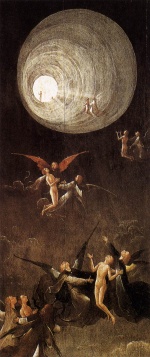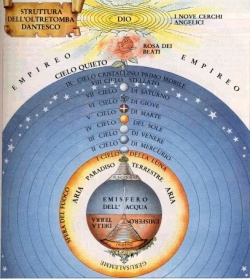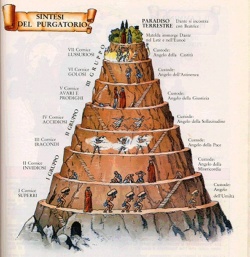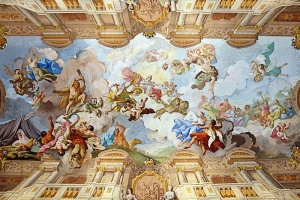Life after Death: Difference between revisions
Pablo Sender (talk | contribs) |
Pablo Sender (talk | contribs) |
||
| Line 60: | Line 60: | ||
== Reincarnation == | == Reincarnation == | ||
When the period of [[Devachan]] is over, the [[Ego#Higher ego|higher ego]] begins the process of [[reincarnation]]. Before it is reborn, however, it sees the life about to be started in its general characteristics, as delineated by its [[Karma]]: | When the period of [[Devachan]] is over, the [[Ego#Higher ego|higher ego]] begins the process of [[reincarnation]]. Before it is reborn, however, it sees the life about to be started in its general characteristics, as delineated by its [[Karma]]. [[Helena Petrovna Blavatsky|Mme. Blavatsky]] wrote: | ||
<blockquote>As the man at the moment of death has a retrospective insight into the life he has led, so, at the moment he is reborn on to earth, the Ego, awaking from the state of Devachan, has a prospective vision of the life which awaits him, and realizes all the causes that have led to it. He realizes them and sees futurity, because it is between Devachan and re-birth that the Ego regains his full manasic consciousness, and rebecomes for a short time the god he was, before, in compliance with Karmic law, he first descended into matter and incarnated in the first man of flesh.<ref>Helena Petrovna Blavatsky, ''The Key to Theosophy'' (London: Theosophical Publishing House, [1987]), 162-163.</ref></blockquote> | <blockquote>As the man at the moment of death has a retrospective insight into the life he has led, so, at the moment he is reborn on to earth, the Ego, awaking from the state of Devachan, has a prospective vision of the life which awaits him, and realizes all the causes that have led to it. He realizes them and sees futurity, because it is between Devachan and re-birth that the Ego regains his full manasic consciousness, and rebecomes for a short time the god he was, before, in compliance with Karmic law, he first descended into matter and incarnated in the first man of flesh.<ref>Helena Petrovna Blavatsky, ''The Key to Theosophy'' (London: Theosophical Publishing House, [1987]), 162-163.</ref></blockquote> | ||
Revision as of 22:12, 27 February 2014
According to the Theosophical tradition, when the death of the body is completed consciousness undergoes a series of transformations. The tendencies, emotions, thoughts, memories, and aspirations that were part of the personality are sorted out. Anything that belonged to the entirely personal and selfish is discarded, while all that was of a generous or unselfish nature is preserved and assimilated by the soul. In the writings of H. P. Blavatsky and the Masters of Wisdom the most frequent description of the different stages after physical death include: a) "death struggle", b) gestation, c) devachan, and d) reincarnation.
General description
In the Theosophical view, death is not the end of conscious experience but, on the contrary, it is the beginning of a wider consciousness. H. P. Blavatsky said:
We accept consciousness after death, and say the real consciousness and the real freedom of the Ego or the soul begins only after the physical death of man. It is then that it is no longer impeded by terrestrial matter that it is free, that it can perceive everything.[1]
What is known as "death" involves the departure of the vital principle and the consequent dissolution of the physical body along with its astral double of etheral matter. After this, comes a period of dissolution of the animal soul and the personal aspect of the human soul in Kāmaloka. Finally, the spiritual aspect of the human soul is assimilated by the spiritual soul in Devachan. In Mme. Blavatsky's words:
Soul being a generic term, there are in men three aspects of Soul - the terrestrial, or animal; the Human Soul; and the Spiritual Soul; these, strictly speaking, are one Soul in its three aspects. Now of the first aspect nothing remains after death; of the second (nous or Manas) only its divine essence if left unsoiled survives, while the third in addition to being immortal becomes consciously divine, by the assimilation of the higher Manas.[2]
The spiritual soul or Buddhi, by itself lacking the element of self-awareness, becomes conscious of its nature due to the presence of the manasic principle assimilated after death.
The different stages have been described by the Master K.H. in one of his letters as follows:
The period between death and rebirth . . . may last from a few years to a kalpa. It is divided into three sub-periods (1) when the Ego delivered of its mortal coil enters into Kama-Loka (the abode of Elementaries); (2) when it enters into its "Gestation State"; (3) when it is reborn in the Rupa-Loka of Deva-Chan. Sub-period (1) may last from a few minutes to a number of years — the phrase "a few years" becoming puzzling and utterly worthless without a more complete explanation; Sub-period (2) is "very long"; as you say, longer sometimes than you may even imagine, yet proportionate to the Ego's spiritual stamina; Sub-period (3) lasts in proportion to the good KARMA, after which the monad is again reincarnated.[3]
The "Death struggle"
After the physical death the four principles of consciousness remaining enter in Kāmaloka, where a purification is to take place. H. P. Blavatsky described the process as follows:
Kama-loka may be compared to the dressing-room of an actor, in which he divests himself of the costume of the last part he played before rebecoming himself properly - the immortal Ego or the Pilgrim cycling in his Round of Incarnations. The Eternal Ego being stripped in Kama-loka of its lower terrestrial principles, with their passions and desires, it enters into the state of Devachan. And therefore it is said that only the purely spiritual, the non-material emotions, affections and aspirations accompany the Ego into that state of Bliss. But the process of stripping off the lower, the fourth and part of the fifth, principles is an unconscious one in all normal human beings. It is only in very exceptional cases that there is a slight return to consciousness in Kama-loka: and this is the case of very materialistic unspiritual personalities, who, devoid of the conditions requisite, cannot enter the state of absolute Rest and Bliss.[4]
In this state, the two lower principles present a tendency towards materiality, while the two higher are of a spiritual nature. What happens can be metaphorically seen as a "struggle" between Kāma and Buddhi to assimilate Manas. In one of his letters, Master K.H. expalined this as follows:
When man dies his second and third principles die with him; the lower triad disappears, and the fourth, fifth, sixth and seventh principles form the surviving Quaternary. . . . Thenceforth it is a "death" struggle between the Upper and Lower dualities. If the upper wins, the sixth, having attracted to itself the quintessence of Good from the fifth — its nobler affections, its saintly (though they be earthly) aspirations, and the most Spiritualised portions of its mind — follows its divine elder (the 7th) into the "Gestation" State; and the fifth and fourth remain in association as an empty shell — (the expression is quite correct) — to roam in the earth's atmosphere, with half the personal memory gone, and the more brutal instincts fully alive for a certain period.[5]
Regarding the time elapsed by a normal person in Kāmaloka, Mme. Blavatsky wrote:
The normal period during which any part of the consciousness remains in Kâma-Loka, i.e., is connected with the Kâma-Rûpa, is one hundred and fifty years. The Kâma-Rûpa eventually breaks up, and leaving in Kâma-Loka the TâŠhic Elementals (p. 609), its remaining portions go into animals.[6]
After the death struggle the two higher principles, along with the spiritual essence of manas, enter into a period of gestation. Meanwhile the fourth principle (Kāma), with whatever personal and selfish element it could retain from the manasic principle, forms a shell and stays in Kāmaloka to be eventually dissolved. However, it may happen that the upper duad does not succeed in assimilating any spiritual essence from the lower duad. As the Master continued saying:
If, on the other hand, it is the Upper Duality which is defeated, then it is the fifth principle that assimilates all that there may be left of personal recollection and perceptions of its personal individuality in the sixth. But, with all this additional stock, it will not remain in Kama-Loka — “the world of Desire” or our Earth’s atmosphere. In a very short time like a straw floating within the attraction of the vortices and pits of the Maelstrom, it is caught up and drawn into the great whirlpool of human Egos; while the sixth and seventh — now a purely spiritual, individual MONAD, with nothing left in it of the late personality, having no regular “gestation” period to pass through (since there is no purified personal Ego to be reborn), after a more or less prolonged period of unconscious Rest in the boundless Space — will find itself reborn in another personality on the next planet. When arrives the period of “Full Individual Consciousness” — which precedes that of Absolute Consciousness in the Pari-Nirvana — this lost personal life becomes as a torn out page in the great Book of Lives, without even a disconnected word left to mark its absence. The purified monad will neither perceive nor remember it in the series of its past rebirths — which it would had it gone to the “World of Forms” (rupa-loka) — and its retrospective glance will not perceive even the slightest sign to indicate that it had been.[7]
Period of gestation
A. P. Sinnett wrote:
When the division of, or purification of the fifth principle has been accomplished in Kama loca by the contending attractions of the fourth and sixth principles, the real Ego passes into a period of unconscious gestation . . . a spiritual ante-natal state at the entrance to spiritual life . . . and this period, in different cases, may be of very different duration--from a few moments to immense periods of years.[8]
According to Mme. Blavatsky the gestation period "lasts from a few days to several years",[9] while Mahatma K.H. wrote that it can be very long: "longer sometimes than you may even imagine, yet proportionate to the Ego's spiritual stamina".[10]
It is usually said that the reviving of consciousness "begins after the struggle in Kama-Loka at the door of Devachan, and only after the 'gestation period'".[11]
That remembrance will return slowly and gradually toward the end of the gestation (to the entity or Ego), still more slowly but far more imperfectly and incompletely to the shell, and fully to the Ego at the moment of its entrance into the Devachan.
Devachan
After the period of gestation, the new "devachanic ego" (that is, the pure elements of the personal ego that have been assimilated to the two higher principles) begins to awaken in Devachan. In one of his letters, Master K.H. wrote:
"Who goes to Deva Chan?" The personal Ego of course, but beatified, purified, holy. Every Ego - the combination of the sixth and seventh principles - which after the period of unconscious gestation is reborn into the Devachan, is of necessity as innocent and pure as a new-born babe. The fact of his being reborn at all, shows the preponderance of good over evil in his old personality. And while the Karma (of evil) steps aside for the time being to follow him in his future earth-reincarnations, he brings along with him but the Karma of his good deeds, words, and thoughts, into this Devachan.[12]
Most people go to Devachan, with the exception of those very materialistic, selfish, or evil in whom there is no spiritual manasic elements that can be absorbed by Buddhi. In this case, no formation of a devachanic ego is possible, and the higher principles fall into an unconscious state. Mme. Blavatsky explained:
The seventh and the sixth [principles], that is to say the immortal spirit and its vehicle, the immortal or spiritual soul, enter therein alone (an exceptional case) or, which nearly always takes place, the soul carries in the case of very good people (and even the indifferent and sometimes the very wicked), the essence, so to speak, of the fifth principle which has been withdrawn from the personal EGO (the material soul). It is the latter only, in the case of the irredeemably wicked and when the spiritual and impersonal soul has nothing to withdraw from its individuality (terrestrial personality) because the latter had nothing to offer but the purely material and sensual - that becomes annihilated. Only the individuality, which possesses the most spiritual feelings, can survive by uniting with the immortal principle.[13]
Reincarnation
When the period of Devachan is over, the higher ego begins the process of reincarnation. Before it is reborn, however, it sees the life about to be started in its general characteristics, as delineated by its Karma. Mme. Blavatsky wrote:
As the man at the moment of death has a retrospective insight into the life he has led, so, at the moment he is reborn on to earth, the Ego, awaking from the state of Devachan, has a prospective vision of the life which awaits him, and realizes all the causes that have led to it. He realizes them and sees futurity, because it is between Devachan and re-birth that the Ego regains his full manasic consciousness, and rebecomes for a short time the god he was, before, in compliance with Karmic law, he first descended into matter and incarnated in the first man of flesh.[14]
Is there consciousness before Devachan?
In the early Theosophical literature there are several statements suggesting consciousness only begins after the struggle in Kama-Loka at the door of Devachan:
Every just disembodied four-fold entity — whether it died a natural or violent death, from suicide or accident, mentally sane or insane, young or old, good, bad, or indifferent — loses at the instant of death all recollection, it is mentally — annihilated; it sleeps it’s akasic sleep in the Kama-loka. This state lasts from a few hours, (rarely less) days, weeks, months — sometimes to several years. All this according to the entity, to its mental status at the moment of death, to the character of its death, etc. That remembrance will return slowly and gradually toward the end of the gestation (to the entity or Ego), still more slowly but far more imperfectly and incompletely to the shell, and fully to the Ego at the moment of its entrance into the Devachan.[15]
However, there are some statements that open the possibility of consciousness before devachan. For example, Mme. Blavatsky wrote:
A “spirit,” or the spiritual Ego, cannot descend to the medium, but it can attract the spirit of the latter to itself, and it can do this only during the two intervals—before and after its “gestation period.” Interval the first is that period between the physical death and the merging of the spiritual Ego into that state which is known in the Arhat esoteric doctrine as “Bar-do.” We have translated this as the “gestation” period, and it lasts from a few days to several years, according to the evidence of the adepts. Interval the second lasts so long as the merits of the old Ego entitle the being to reap the fruit of its reward in its new regenerated Egoship. It occurs after the gestation period is over, and the new spiritual Ego is reborn—like the fabled Phœnix from its ashes—from the old one. The locality, which the former inhabits, is called by the northern Buddhist Occultists “Deva-chan”. . .[16]
As can be seen, she describes here the following sequence:
1- Physical death.
2- First interval.
3- Gestation.
4- Second interval (Devachan).
She mentions that the Spiritual Ego can attract to its own sphere the spirit of the medium in either of the intervals, which suggests there can be consciousness before the period of gestation. According to her, this can happen "when the intensity of the desire in the dying person to return for some purpose forced the higher consciousness to remain awake".[17]
According to Annie Besant
Dr. Annie Besant explained that after death the kamic principle rearranges itself into a "desire body" or Kāmarūpa:
This desire body undergoes a marked change soon after death. The different densities of the astral matter of which it is composed arrange themselves in a series of shells or envelopes, the densest being outside, shutting the consciousness away from all but very limited contact and expression. The consciousness turns in on itself, if left undisturbed, and prepares itself for the next step onwards, while the desire body gradually disintegrates, shell after shell.
Up to the point of this re-arrangement of the matter of the desire body, the post-mortem experience of all is much the same; it is a “dreamy, peaceful semi-consciousness”, as before said, and this, in the happiest cases, passes without vivid awakening into the deeper “pre-devachanic unconsciousness” which ends with the blissful wakening in Devachan, heaven, for the period of [Page 33] repose that intervenes between two incarnations. But as, at this point, different possibilities arise.[18]
Now, "if a person has led a pure life and has steadfastly striven to rise and to identify himself with the higher rather than the lower part of his nature" the staying in Kāmaloka is short and normally unconscious. However:
An awakening may be caused by the passionate sorrow and desires of friends left on earth, and these violently vibrating kamic elements in the embodied persons may set up vibrations in the desire body of the disembodied, and so reach and rouse the lower Mind. . . . This awakening is often accompanied with acute suffering, and even if this be avoided, the natural process of the Triad freeing itself is rudely disturbed, and the completion of its freedom is delayed.[19]
In those who during life have being attached to sensual pleasures the manasic consciousness "cannot quickly disentangle itself from the web of its weaving". They experience "a considerable delay in the world of transition, in Kāmaloka, while the desires wear out and fade away to a point at which they can no longer detain the Soul with their clinging arms".[20] The more attached to the physical life a person was, the easily he can be awakened on this plane. In Besant's words:
Human beings, who have quitted earth and in whom the kāmic elements were strong, may very readily be attracted by the kāmic elements in embodied men, and by their help become conscious again of the presence of the scenes they had left; and human beings still embodied may set up methods of communication with the disembodied, and may, as said, leave their own bodies for awhile, and become conscious in Kāmaloka by the use of faculties through which they have accustomed their consciousness to act.[21]
If channels of communication with the physical plane are offered "the period in Kāmaloka is . . . lengthened, the desire body is fed and its hold on the Ego is maintained, and thus is the freedom of the Soul deferred".[22]
Now, people "who have led an evil life, who have gratified and stimulated their animal passions, and have full fed the desire body while they have starved even the lower mind" become Elementaries:
These remain for long, denizens of Kāmaloka, and are filled with yearnings for the earth-life they have left, and for the animal delights that they can no longer – in the absence of the physical body – directly taste. These gather round the medium and the sensitive, endeavouring to utilise them for their own gratification, and these are among the more dangerous of the forces so rashly confronted in their ignorance by the thoughtless and the curious.[23]
Notes
- ↑ Michael Gomes (transcriber), The Secret Doctrine Commentaries (The Hague: I.S.I.S. foundation, 2010), 44.
- ↑ Helena Petrovna Blavatsky, "The Key to Theosophy" (Pasadena, CA: Theosophical University Press, 1972), 121-122.
- ↑ Vicente Hao Chin, Jr., The Mahatma Letters to A.P. Sinnett in chronological sequence No. 68 (Quezon City: Theosophical Publishing House, 1993), 194.
- ↑ Helena Petrovna Blavatsky, Collected Writings vol. IX (Wheaton, IL: Theosophical Publishing House, 1974), 164.
- ↑ Vicente Hao Chin, Jr., The Mahatma Letters to A.P. Sinnett in chronological sequence No. 68 (Quezon City: Theosophical Publishing House, 1993), 192-193.
- ↑ Helena Petrovna Blavatsky, Collected Writings vol. XII (Wheaton, IL: Theosophical Publishing House, 1980), 708.
- ↑ Vicente Hao Chin, Jr., The Mahatma Letters to A.P. Sinnett in chronological sequence No. 68 (Quezon City: Theosophical Publishing House, 1993), 193.
- ↑ Alfred Percy Sinnett, Esoteric Buddhism (San Diego, CA: Wizards Bookshelf, 1987), 96-97.
- ↑ Helena Petrovna Blavatsky, Collected Writings vol. IV (Wheaton, IL: Theosophical Publishing House, 1991), 120-121.
- ↑ Vicente Hao Chin, Jr., The Mahatma Letters to A.P. Sinnett in chronological sequence No. 68 (Quezon City: Theosophical Publishing House, 1993), 194.
- ↑ Vicente Hao Chin, Jr., The Mahatma Letters to A.P. Sinnett in chronological sequence No. 104 (Quezon City: Theosophical Publishing House, 1993), 362.
- ↑ Vicente Hao Chin, Jr., The Mahatma Letters to A.P. Sinnett in chronological sequence No. 68 (Quezon City: Theosophical Publishing House, 1993), 190.
- ↑ Helena Petrovna Blavatsky, Collected Writings vol. V (Wheaton, IL: Theosophical Publishing House, 1997), 42.
- ↑ Helena Petrovna Blavatsky, The Key to Theosophy (London: Theosophical Publishing House, [1987]), 162-163.
- ↑ Vicente Hao Chin, Jr., The Mahatma Letters to A.P. Sinnett in chronological sequence No. 85-B (Quezon City: Theosophical Publishing House, 1993), 263.
- ↑ Helena Petrovna Blavatsky, Collected Writings vol. IV (Wheaton, IL: Theosophical Publishing House, 1991), 120-121.
- ↑ Helena Petrovna Blavatsky, The Key to Theosophy (London:Theosophical Publishing House, [1987]), 151.
- ↑ Annie Besant, Death--And After? (Adyar, Madras:Theosophical Publishing House, 1977), 33.
- ↑ Annie Besant, Death--And After? (Adyar, Madras:Theosophical Publishing House, 1977), 36.
- ↑ Annie Besant, Death--And After? (Adyar, Madras:Theosophical Publishing House, 1977), 36.
- ↑ Annie Besant, Death--And After? (Adyar, Madras:Theosophical Publishing House, 1977), 31.
- ↑ Annie Besant, Death--And After? (Adyar, Madras:Theosophical Publishing House, 1977), 39.
- ↑ Annie Besant, Death--And After? (Adyar, Madras:Theosophical Publishing House, 1977), 39.
Online resources
Articles and pamphlets
- Death and After-Death States at Theosopedia
- Life, and Life After Death by Annie Besant
- When a Man Dies, Shall He Live Again? by Annie Besant
- Dialogue On The Mysteries Of The After Life by H. P. Blavatsky
- Life and Death by H. P. Blavatsky
- The After-death Consciousness and Processes by Geoffrey Farthing
- After Death: You are Yourself by G. de Purucker
- Does the Personality Survive? by L. W. Rogers
- The transpersonal Model of Death as Presented in Madame Blavatsky's Theosophy by Jean-Louis Siémons
- Death and Life Beyond by Theosophical Society in America
Books
- Death - and After? by Annie Besant
- Life beyond Death: evidence for survival by David Pratt
Audio
- Life on the Other Side of Death by Clara Codd
- Tibetan Contributions to Our Knowledge of Death and Dying (4 parts) by Glenn Mullin
Video
- I'm Dead! Now What? by Dick Brooks
- A Theosophical View of Life after Death by Pablo Sender



